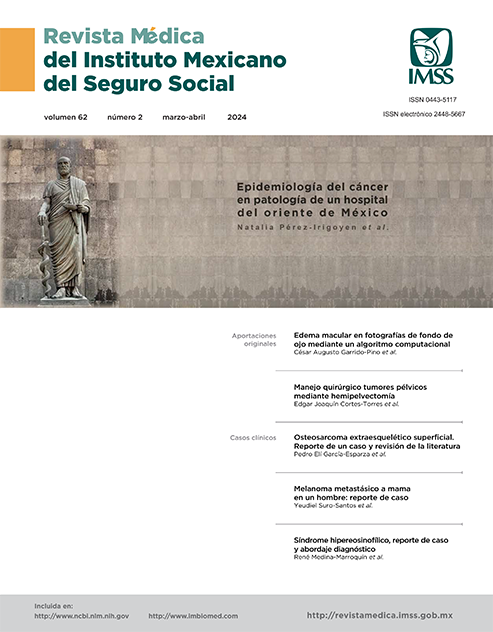Cancer epidemiology in pathology of a hospital in eastern Mexico
Main Article Content
Keywords
Epidemiology, Neoplasms, Incidence
Abstract
Background: Cancer is one of the leading causes of death in the world. In Mexico, its incidence has increased, and differences have been reported regarding the regions of the country.
Objective: To study the epidemiology of malignant neoplasms diagnosed in the Pathology department of a hospital in eastern Mexico.
Material and methods: We studied the different cancer types diagnosed in Pathology of the Hospital Centro Médico Nacional “General de División Manuel Ávila Camacho” during 2019.
Results: In the region, women were more affected than men, presenting more cases. In the total population, we found a high proportion of breast and skin cancers and a decreased proportion of lung cancer, both compared with Mexico and the world (2020). In men, we found a decreased prostate cancer proportion compared to Mexico. We also observed a high proportion of skin cancer (higher than Mexico and the world) and a high percentage of higher digestive system cases, compared to Mexico. For women, we found a high percentage of breast and skin cancers compared to Mexico and the world; and a decreased percentage of cervical cancer when compared to data from Mexico.
Conclusions: Knowing cancer epidemiology in the regions of Mexico can help implement cancer control, screening activities and to provide a timely treatment.
References
Padilla-Raygoza N, Monroy-Torres R, Sandoval-Salazar C, et al. Cancer prevention programmes in Mexico: are we doing enough? Ecancermedicalscience. 2020;14:997. doi: 10.3332/ecancer.2020.997.
Collaboration GBoDC. Cancer Incidence, Mortality, Years of Life Lost, Years Lived With Disability, and Disability-Adjusted Life Years for 29 Cancer Groups From 2010 to 2019: A Systematic Analysis for the Global Burden of Disease Study 2019. JAMA Oncology. 2022;8(3):420-44. doi: 10.1001/jamaoncol.2021.6987.
Instituto Nacional de Estadística y Geografía. Estadísticas a Propósito Del Día Mundial Contra El Cáncer (4 De Febrero) Datos Nacionales. 2022(Comunicado de prensa núm. 74/22):1-5.
Reynoso-Noverón N, Chang S, Herrera-Montalvo LA, et al. Cancer Prevention Behaviors in Workers of a Referral Cancer Center in Mexico City: A Pilot Study on Early Detection Awareness for Cancer. Cancer control: journal of the Moffitt Cancer Center. 2022;29:10732748221133625. doi: 10.1177/10732748221133625.
Mohar-Betancourt A, Reynoso-Noverón N, Armas-Texta D, et al. Cancer Trends in Mexico: Essential Data for the Creation and Follow-Up of Public Policies. Journal of global oncology. 2017;3(6):740-8. doi: 10.1200/jgo.2016.007476.
Informe ejecutivo sobre las tendencias de mortalidad por cáncer en México a nivel nacional. All.Can: México. México: Fundación Mexicana para la Salud, A.C.; 2022.
Sung H, Ferlay J, Siegel RL, et al. Global Cancer Statistics 2020: GLOBOCAN Estimates of Incidence and Mortality Worldwide for 36 Cancers in 185 Countries. CA: a cancer journal for clinicians. 2021;71(3):209-49. doi: 10.3322/caac.21660.
Secretaría de Salud. Compendio de Patología mamaria. 2002.
Consenso mexicano sobre diagnóstico y tratamiento del cáncer mamario. Gaceta Mexicana de Oncología. 2021;20(Suppl 2):106.
WHO. WHO Classification of Tumours. In: Board WCoTE, editor. Breast Tumours. 5th edition ed: IARC; 2019.
Secretaría de Salud. Diagnóstico y Tratamiento del Carcinoma Basocelular. Guía de Evidencias y Recomendaciones: Guía de Práctica Clínica. In: CENETEC, editor. México; 2019.
Téllez-Bernal E, Fernández-Tamayo NM, et al. Incidencia de tumores malignos en pacientes adultos diagnosticados por primera vez en el hospital Instituto de Seguridad y Servicio Social al Servicio de los Trabajadores del Estado de Puebla en el año 2013. Gaceta Mexicana de Oncología. 2015;14(2):75-8. doi: https://doi.org/10.1016/j.gamo.2015.06.014.
Deo SVS, Sharma J, Kumar S. GLOBOCAN 2020 Report on Global Cancer Burden: Challenges and Opportunities for Surgical Oncologists. Annals of surgical oncology. 2022;29(11):6497-500. doi: 10.1245/s10434-022-12151-6.
Secretaría de Salud. Abordaje Diagnóstico del Melanoma Maligno. Guía de Práctica Clínica GPC IMSS-547-12.
Ahmed B, Qadir MI, Ghafoor S. Malignant Melanoma: Skin Cancer-Diagnosis, Prevention, and Treatment. Critical reviews in eukaryotic gene expression. 2020;30(4):291-7. doi: 10.1615/CritRevEukaryotGeneExpr.2020028454.
Ciuciulete AR, Stepan AE, Andreiana BC, et al. Non-Melanoma Skin Cancer: Statistical Associations between Clinical Parameters. Current health sciences journal. 2022;48(1):110-5. doi: 10.12865/chsj.48.01.16.
Heath MS, Bar A. Basal Cell Carcinoma. Dermatologic clinics. 2023;41(1):13-21. doi: 10.1016/j.det.2022.07.005.
Firnhaber JM. Basal Cell and Cutaneous Squamous Cell Carcinomas: Diagnosis and Treatment. American family physician. 2020;102(6):339-46.
Stătescu L, Cojocaru E, Trandafir LM, et al. Catching Cancer Early: The Importance of Dermato-Oncology Screening. Cancers. 2023;15(12). doi: 10.3390/cancers15123066.
Arango-Bravo EA, Cetina-Pérez LDC, Galicia-Carmona T, et al. The health system and access to treatment in patients with cervical cancer in Mexico. Front Oncol. 2022;12:1028291. doi: 10.3389/fonc.2022.1028291.
Camacho-Beiza IR, Ocaña- Servín HL, Hardy-Pérez A, et al. Mortality from pulmonary cancer in Mexico from 2000-2020 and its relation to the history of tobacco. Revista de Medicina e Investigación. 2022;10(2):9.
Miranda-Filho A, Piñeros M, Bray F. The descriptive epidemiology of lung cancer and tobacco control: a global overview 2018. Salud Pública de México. 2019;61(3). doi: https://doi.org/10.21149/10140.
Reynales-Shigematsu LM, Wipfli H, Samet J, et al. Tobacco control in Mexico: a decade of progress and challenges. Salud Pública de México. 2019;61(3):11. doi: https://doi.org/10.21149/9360.
Mendoza-Cano O, Murillo-Zamora E, Ochoa-Martínez ÁC, et al. Insight into the Burden of Malignant Respiratory Tumors and their Relationship with Smoking Rates and Lead Contamination in Mexico. Toxics. 2022;10(11). doi: 10.3390/toxics10110708.
Maycotte P, Medina-Benítez D, Ramírez-Torres N, et al. [Molecular diagnosis of breast cancer: prognostic and therapeutic implications]. Rev Med Inst Mex Seguro Soc. 2020;58(Supl 1):S62-s74. doi: 10.24875/rmimss.M20000116.
Bray F, Møller B. Predicting the future burden of cancer. Nat Rev Cancer. 2006;6(1):63-74. doi: 10.1038/nrc1781.


